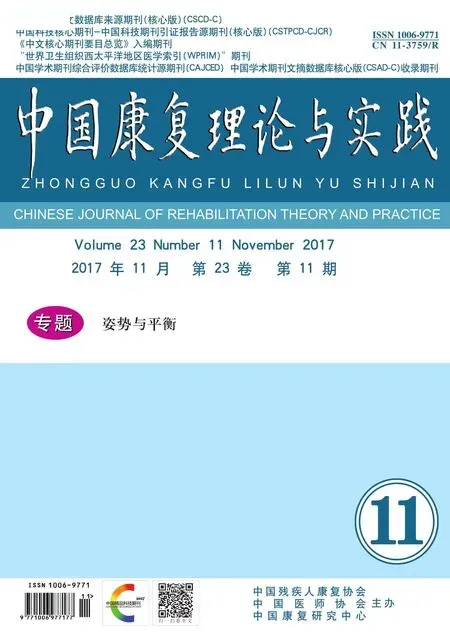脑卒中偏瘫患者预期性姿势调节的研究进展①
尹群辉,张皓,2
脑卒中偏瘫患者预期性姿势调节的研究进展①
尹群辉1,张皓1,2
预期性姿势调节可以更精细反映姿势控制的能力。本文简单介绍姿势控制的两种神经肌肉调节方式。脑卒中偏瘫患者在直立及步态启动过程下,预期性姿势调节障碍,表现为肌肉激活时间延迟、激活程度降低、募集次序退化以及适应性降低。
脑卒中;姿势控制;预期性姿势调节;综述
脑卒中患者由于中枢神经系统(central nervous system,CNS)损害,导致姿势控制异常。预期性姿势调节(anticipatory postural adjustments,APAs)作为姿势控制的神经肌肉调节方式之一,可以更精细地反应姿势控制的能力。近年来,国外不少学者对其进行深入研究,不少文献报道了脑卒中偏瘫患者APAs障碍的特点。
1 姿势控制与姿势调节
姿势控制属于运动控制的范围,是指在各种活动中保持躯体在空间位置的能力[1];它包括姿势稳定性及姿势方向性。姿势稳定性指身体面对内外干扰时,通过感觉整合维持身体质心在支撑面内的能力,也被称作平衡,主要与躯干内在干扰有关;姿势方向性指在执行不同运动模式中对身体姿势的主动控制的能力,与环境、重力、支撑面等诸多因素相关[2]。
姿势控制是一个复杂的过程,由感觉整合、躯干生物力学成分及神经肌肉调节相互作用构成;并受年龄、疾病、生理状态(如疲劳)、心理负荷(如认知、情绪等)的影响[3]。
大量研究表明,CNS在应对内外环境干扰时,主要通过APAs和补偿性姿势调节(compensatory postural adjustments,CPAs)对姿势控制进行调节。
1967年,Belen'kiĭ等[4]发现姿势肌的肌电活动出现在上肢随意运动之前。他们在受试者完成举臂动作时,同时检测姿势肌(腿和躯干)和原发运动肌(手臂)肌电活动,发现同侧股二头头肌的肌电活动在三角肌前50~60 ms激活。根据实验结果,他们将姿势肌的活动分为两部分,准备期和补偿期:姿势肌在原发运动肌激活前50 ms发生激活,为运动的代偿做准备,称准备期;在原发运动后,姿势肌再次被激活,进一步维持躯体的稳定性,称补偿期。该研究第一次提出姿势控制中前馈及反馈模式存在。其后,研究者们[5-7]通过大量上肢随意运动,详细地描述了姿势肌(腿和躯干)的APAs的特点。
APAs在可预期干扰之前发生。CNS通过调动姿势肌群产生与干扰相反的作用力,使身体质心仍落在支撑面内,维持姿势稳定[8],但未改变各关节的运动模式,更多地体现在运动幅度减小[9]。这种调节方式主要通过前馈方式进行,并可通过后天学习获得[10]。
APAs具有时间、空间及数量三个主要特征[8]。时间主要指干扰发生前100 ms及运动后50 ms时间范围,空间主要指姿势肌激活的顺序和协调性,数量常通过一些技术参数,如表面肌电(surface electromyography,sEMG)、速度、角度等进行定量描述。此外,实验中还常用到压力中心(contre of pressure,CoP)、质心(centre of mass,CoM)、地面反作用力(ground reaction forces,GRF)[11]等参数描述APAs特征。
CPAs在干扰之后发生。CNS对干扰引起的三大感觉反馈(视觉、前庭觉、本体感觉)进行整合,调整姿势肌及原发运动肌,使身体尽可能恢复平衡状态[12-13]。这种调节主要通过反馈方式进行,并且受到先前经验的影响[14]。
APAs仅存在于可预期干扰,CPAs既存在于可预期的干扰时(在APAs后,干扰发生后50~100 ms),也可以在不可预期的干扰时观察到[1]。在不同干扰模式下,个体可能会表现出不同的CPAs,主要体现在姿势策略(postural strategy)和姿势协同(postural synergy)两方面。任何感觉传入通路及高级皮层功能受损或者退化,都将影响CPAs[15]。
2 姿势干扰
人体在站立或行走过程中,平衡会受到内外两种干扰:内在干扰指躯干或四肢自主产生的各种目标运动[16],如上肢、躯干自主伸展活动,目前临床试验常用的运动模式有腿部运动、躯干直立的上肢运动、上肢伸展的去负荷运动、双重任务状态以及不需维持直立姿势的前臂作业等[17];外部干扰指对稳定姿势有意图地施予干扰条件,并以此达到在稳定条件下观察不到的人体姿势控制能力[18],如突然的冲撞,临床常用酒保试验、重物垂落试验、钟摆试验等外界干扰研究姿势调节机制[17]。研究中根据干扰是否可预期将其分为预期性姿势干扰与非预期性姿势干扰。
Santos等[19]在对下肢肌肉活动的APAs研究中发现,干扰的可预期程度越低,APAs水平越低,CPAs反应越强烈。谢琳等[20]发现,由于内在干扰发生时间明确,CNS主要通过对姿势肌APAs强度的调节来实现姿势控制;而在外部姿势干扰时,由于干扰时间不明确,CNS通过对局部稳定肌APAs预激活时间以及局部稳定肌和整体稳定肌APAs强度的双重调节,实现姿势肌肉的优化控制。
3 脑卒中偏瘫患者的APAs
脑卒中以高发病率、高致残率和高死亡率,成为严重威胁人类健康的重大疾病。脑卒中可导致各种神经功能障碍,其中以偏瘫最为常见,对患者日常生活活动能力和生活质量造成严重影响[21]。在脑卒中偏瘫患者运动的功能恢复中,姿势控制能力是重要的影响因素之一。
影响脑卒中后偏瘫患者姿势控制能力的因素非常多[22],如肌肉骨骼系统损害,包括异常的肌张力、肌力下降、关节活动度范围受限;神经-肌肉协调运动功能障碍;感觉器官成分损害;认知功能减退甚至心理因素等,各因素之间存在不同程度耦合。不同的脑卒中偏瘫患者,影响姿势控制的因素可能存在差异,各个因素的权重和相互关系也各不相同。
APAs的调控是一个复杂的网络系统,涉及脊髓、脑干网状结构、小脑、基底神经节及大脑皮层等多个神经结构;如大脑皮层的前运动皮层(premotor cortex,PMC)、辅助运动区(supplementary motor area,SMA)、初级运动区(primary motor area,M1)、前额叶皮层区(prefrontal cortex area)等[23-24]。脑卒中偏瘫患者由于中枢神经损害及代偿机制,导致APAs障碍。
目前许多研究表明,脑卒中后偏瘫患者存在APAs障碍,并且在偏瘫侧表现得更为明显。患者可通过学习激活原先的运动记忆,重新获得APAs能力[25]。以下主要介绍在躯干直立及步态启动过程APAs障碍的相关研究。
3.1 躯干直立
在坐位保持躯干直立的上肢或腿部随意运动中,研究者主要观察核心肌群在姿势控制中的APAs障碍。早期人们发现核心肌群主要表现为双侧协调障碍。Palmer等[26]发现,在健侧上肢外展运动中,患侧背阔肌肌电信号减弱;而在患侧上肢外展运动中,虽然患侧三角肌等原发动肌肌电信号仍较弱,但健侧背阔肌信号增强。Slijper等[27]的去负荷试验证实核心肌群失协调:患侧竖脊肌及腹直肌肌电活动较健侧减弱。
此外有研究发现,在上肢运动模式中,主要表现为躯干肌群募集延迟[26,28]。随着研究深入,Dickstein等[29]发现,与正常人相比,偏瘫患者主要表现为患侧外侧核心肌群腹外斜肌和背阔肌APAs障碍,具体表现为肌肉募集延迟、肌电活动强度减弱及相关肌肉募集次序退化。Pereira等[30]进一步发现核心肌群APAs与上肢运动速度不具有相关性,这与正常人不同,说明偏瘫患者姿势调节的适应性存在一定障碍。
由此可见,脑卒中后偏瘫患者核心肌群APAs确实存在障碍,但是否仅为单侧障碍仍存在质疑,可能与核心肌群在某种程度上仍存在双侧轴线传导有关[31]。即使脑卒中病灶位于单侧脑组织,也可能导致双侧核心肌群活动减弱。
在站立位躯干直立时,偏瘫患者由于质心偏向健侧,造成的继发性姿势不对称,并需要更多注意来维持姿势平衡等,导致姿势控制更加复杂;其中APAs涉及姿势肌的激活、GRF、压力中心的变化等,以维持平衡[32]。患者必须多关节联合协调,同时维持姿势控制和执行目标动作[33]。
McCombe等[34]在声音干扰的站立位上肢自主伸展试验中发现,即使干扰的预期性程度很高,偏瘫患者的APAs阶段和动作执行过程中反应时间均延迟,并且两阶段的姿势肌和原发运动肌肌电幅度均出现不同程度降低;声音干扰仅对动作执行阶段的肱二头肌产生提前激活。表明随姿势控制复杂程度增加,干扰的预期性并不能完全代偿姿势调节,仍存在APAs障碍;CPAs启动延迟,导致动作执行障碍;面对外界惊吓,患者可通过激活屈肘肌来防护身体。Pollock等[35]发现,偏瘫患者APAs阶段生理唤醒程度更高;在重复干扰试验中,健康人CPAs阶段生理唤醒具有惯性,这种惯性在偏瘫患者减弱甚至缺失,表明患者APAs适应性降低。
也有人发现偏瘫患者在坐-站立位转换时,姿势肌群募集次序改变[36]:比目鱼肌在目标动作之前被激活,正常人则表现为胫前肌首先激活。
3.2 步态
正常人在由支撑相向摆动相转移时,涉及一系列复杂的APAs机制。在双支撑相向单支撑相转化阶段,APAs可分为4个阶段:原支撑腿负荷、原支撑腿去负荷、压力中心向对侧(支撑腿)后侧转移、压力中心向对侧外侧转移。正常人至少有一个阶段APAs缺失,最常发生于原支撑腿负荷阶段[37]。
脑卒中偏瘫患者由于肌力下降及自主运动缺失,导致步态启动阶段APAs障碍[38]。Sousa等[39]发现,偏瘫患者在自主步态启动时,双下肢踝关节APAs障碍:患侧胫前肌激活和腓肠肌抑制均存在障碍,而健侧仅表现出腓肠肌抑制障碍。Martinez等[11]则发现,相较于自主步行,偏瘫患者诱导步行时APAs时程减少,可能与诱导步行时原支撑腿去负荷时程减少有关。
Patchay等[40]发现,正常人由于身体重力分布不对称,在步态启动过程中影响压力中心运动模式,使得内外侧压力中心(medio-lateral centre of pressure,ML COP)位移减少。考虑到偏瘫患者压力中心偏向于健侧,因此当患者健腿支撑时,患肢可能不需要APAs使质心向健侧转移。有人认为,在单侧损伤的脑卒中患者中,可能存在非典型性APAs的可能。Ajachandrakumar等[41]在亚急性期偏瘫患者步态启动研究中,根据ML COP变化将APAs更为细致地划分为典型性APAs和非典型性APAs,前者指单一性APAs,后者主要指缺失性(向摆动腿侧无意义性ML COP位移)或多样性(重复ML COP位移)APAs。研究发现,亚急性期患者35%表现为非典型APAs,且步行速度越快,APAs缺失频率越大;而患腿支撑时,主要表现为多样性APAs。相比典型APAs,这种多样性APAs可以使患者预期调节时间延长,步态启动延迟,导致姿势不稳定,增加跌倒风险。这在脑卒中和帕金森病患者中均有体现。也有人认为这种多样性APAs可能反映了步态准备或执行障碍[42-43]。由于该研究纳入的患者主要为亚急性期,对于恢复期步态的非典型APAs有待深入研究。
4 总结
综上所述,与正常人相比,脑卒中偏瘫患者姿势控制的APAs存在障碍,具体表现为肌肉激活时间延迟、激活程度降低、肌肉募集次序退化,APAs适应性降低;而具体的APAs障碍在不同运动模式中有不同表现,可能与不同运动模式激发不同姿势策略及姿势协调代偿有关。然而目前研究对受试者的痉挛模式、肌力、肌张力等影响因素控制的叙述模棱两可,试验准确性及重复性有待提高。
除脑卒中外,还有其他关于正常年轻人、老年人、帕金森病患者等APAs研究。由于APAs仅涉及干扰前100 ms,有利于我们更加精细地评估患者的姿势调节障碍,准确地指导康复治疗;同时,可能有助于我们探讨脑卒中后APAs的中枢重塑机制,并进一步开发新的康复治疗手段。
[1]Shumway-Cook A,Woollacott M.运动控制:原理与实践[M].3版.毕胜,燕铁斌,王宁华,译.北京:人民卫生出版社,2009:3-155.
[2]Sousa AS,Silva A,Tavares JM.Biomechanical and neurophysiological mechanisms related to postural control and efficiency of movement:a review[J].Somatosens Mot Res,2012,29(4):131-143.
[3]Yiou E,Caderby T,Hussein T.Adaptability of anticipatory postural adjustments associated with voluntary movement[J].World J Orthop,2012,3(6):75-86.
[4]Belen'kiĭ VE,Gurfinkel'VS,Pal'tsev EI.Control elements of voluntary movements[J].Biofizika,1967,12:135-141.
[5]Cordo PJ,Nashner LM.Properties of postural adjustments associated with rapid arm movements[J].J Neurophysiol,1982,47(2):287-302.
[6]Zattara M,Bouisset S.Posturo-kinetic organisation during the early phase of voluntary upper limb movement.1.Normal subjects[J].J Neurol Neurosurg Psychiatry,1988,51(7):956-965.
[7]Friedli WG,Hallett M,Simon SR,et al.Postural adjustments associated with rapid voluntary arm movements.II.Biomechanical analysis[J].J Neurol Neurosurg Psychiatry,1988,51(2):232-243.
[8]Yoshida S,Nakazawa K,Shimizu E,et al.Anticipatory postural adjustments modify the movement-related potentials of upper extremity voluntary movement[J].Gait Posture,2008,27(1):97-102.
[9]温子星,徐欣,潘景文.预测性姿势调节对人体站立受扰后姿势响应影响的研究[J].中国康复医学杂志,2016,31(10):1104-1110.
[10]Witherington DC,von Hofsten C,Rosander K.The development of anticipatory postural adjustments in infancy[J].Infancy,2002,3(4):495-517.
[11]Martinez KM,Mille ML,Zhang Y.Stepping in persons poststroke:comparison of voluntary and perturbation-induced responses[J].Arch Phys Med Rehabi,2013,94(12):2425-2432.
[12]Park S,Horak FB,Kuo AD.Postural feedback responses scale with biomechanical constraints in human standing[J].Exp Brain Res,2004,154(4):417-427.
[13]AlexandrovAV,Frolov AA,Horak FB,et al.Feedback equilibrium control during human standing[J].Biol Cybern,2005,93(5):309-322.
[14]Horak EB.Postural control[M]//Horak EB.Encyclopedia of Neuroscience.Berlin Heidelberg:Springer,2009:3212-3219.
[15]Claudino R,dos Santos EC,Santos MJ.Compensatory but not anticipatory adjustments are altered in older adults during lateral postural perturbations[J].Clin Neurophysiol,2013,124:1628-1637.
[16]渡部和彦,壬芸.老年人的身体平衡能力与外部干扰适应理论[J].体育科学,2014,34(2):54-59.
[17]张芷,王健.预期与补偿姿势控制的注意效应[D].杭州:浙江大学,2014.
[18]Aruin SA.The organization of anticipatory postural adjustments[J].JAutom Contr,2002,12(1):31-37.
[19]Santos MJ,Kanekar N,AruinAS.The role of anticipatory postural adjustments in compensatory control of posture:1.Electromyographic analysis[J].J Electromyogr Kinesiol,2010,20(3):388-397.
[20]谢琳,王健,张芷,等.姿势干扰强度的预期效应[J].浙江大学,2015,46(7):951-959.
[21]Bohannon RW,Leary KM.Standing balance and function over the course of acute rehabilitation[J].Arch Phys Med Rehabil,1995,76(11):994-996.
[22]Tasseel-Ponche S,Yelnik AP,Bonan IV.Motor strategies of postural control after hemispheric stroke[J].Neurophysiol Clin,2015,45(4-5):327-333.
[23]Richard A,van Hamme A,Drevelle X,et al.Contribution of the supplementary motor area and the cerebellum to the anticipatory postural adjustments and execution phases of human gait initiation[J].Neuroscience,2017,358:181-189.
[24]Chang WH,Tang PF,Wang YH,et al.Role of the premotor cortex in leg selection and anticipatory postural adjustments associated with a rapid stepping task in patients with stroke[J].Gait Posture,2010,32(4):487-493.
[25]Forget R,Lamarre Y.Postural adjustments associated with different unloading of the forearm:effects of proprioceptive and cutaneous afferent deprivation[J].Can J Physiol Pharmacol,1995,73(2):285-294.
[26]Palmer E,Downes L,Ashby P.Associated postural adjustments are impaired by lesions of the cortex[J].Neurology,1996,46(2):471-475.
[27]Slijper H,Latash ML,Rao N,et al.Task-specific modulation of anticipatory postural adjustments in individuals with hemiparesis[J].Clin Neurophysiol,2002,113(5):642-655.
[28]Horak FB,Esselman P,Anderson ME,et al.The effects of movement velocity,mass displaced,and task certainty on associated postural adjustments made by normal and hemiplegic individuals[J].J Neurol Neurosurg Psychiatry,1984,47(9):1020-1028.
[29]Dickstein R,Shefi S,Marcovitz E,et al.Anticipatory postural adjustment in selected trunk muscles in poststroke hemiparetic patients[J].Arch Phys Med Rehabil,2004,85(2):261-267.
[30]Pereira S,Silva CC,Ferreira S,et al.Anticipatory postural adjustments during sitting reach movement in post-stroke subjects[J].J Electromyogr Kinesiol,2014,24(1):165-171.
[31]Carr LJ,Harrison LM,Stephens JA.Evidence for bilateral innervation ofcertain homologousmotoneurone poolsin man[J].J Physiol,1994,475(2):217-227.
[32]Massion J,Alexandrov A,Frolov A.Why and how are posture and movement coordinated?[J].Prog Brain Res,2004,143:13-27.
[33]Kusoffsky A,Apel I,Hirschfeld H.Reaching-lifting-placing task during standing after stroke:coordination among ground forces,ankle muscle activity,and hand movement[J].Arch Phys Med Rehabil,2001,82(5):650-660.
[34]McCombe Waller S,Yang CL,Magder L,et al.Impaired motor preparation and execution during standing reach in people with chronic stroke[J].Neurosci Lett,2016,630:38-44.
[35]Pollock CL,Carpenter MG,Hunt MA,et al.Physiological arousal accompanying postural responses to external perturbations after stroke[J].Clin Neurophysiol,2017,128(6):935-944.
[36]Silva A,Sousa AS,Pinheiro R,et al.Activation timing of soleus and tibialis anterior muscles during sit-to-stand and stand-to-sit in post-stroke vs.healthy subjects[J].Somatosens Mot Res,2013,30(1):48-55.
[37]Lu C,Amundsen Huffmaster SL,Harvey JC.Anticipatory postural adjustment patterns during gait initiation across the adult lifespan[J].Gait Posture,2017,57:182-187.
[38]Neckel N,Pelliccio M,Nichols D,et al.Quantification of functional weakness and abnormal synergy patterns in the lower limb of individuals with chronic stroke[J].J Neuroeng Rehabil,2006,3:17.
[39]Sousa AS,Silva A.Ankle anticipatory postural adjustments during gait initiation in healthy and post-stroke subjects[J].Clin Biomech(Bristol,Avon),2015,30(9):960-965.
[40]Patchay S,Gahéry Y.Effect of asymmetrical limb loading on early postural adjustments associated with gait initiation in young health adults[J].Gait Posture,2003,18(1):85-94.
[41]Ajachandrakumar R,Fraser JE,Schinkel-Ivy A,et al.Atypical anticipatory postural adjustments during gait initiation among individuals with sub-acute stroke[J].Gait Posture,2017,52:325-331.
[42]Jacobs JV,Horak FB.External postural perturbations induce multiple anticipatory postural adjustments when subjects cannot pre-select their stepping foot[J].Exp Brain Res,2007,179(1):29-42.
[43]Jacobs JV,Nutt JG,Carlson-Kuhta P,et al.Knee trembling during freezing of gait represents multiple anticipatory postural adjustments[J].Exp Neurol,2009,215(2):334-341.
Advance inAnticipatory PosturalAdjustments for Stroke Patients with Hemiplegia(review)
YIN Qun-hui1,ZHANG Hao1,2
1.Capital Medical University School of Rehabilitation Medicine,Beijing 100068,China;2.Department of Neurorehabilitation,Beijing Bo'ai Hospital,China Rehabilitation Research Center,Beijing 100068,China
ZHANG Hao.E-mail:zh1665@163.com
The anticipatory postural adjustments can be more precise in reflecting the ability of posture control,which associate with two kinds of neuromuscular model.Anticipatory postural adjustments disorders are found in stroke patients with hemiplegia,such as delay of muscle activation time,decrease of muscle activation,degradation of muscle recruitment order and reduction of adaptability.
stroke;posture control;anticipatory postural adjustments;review
10.3969/j.issn.1006-9771.2017.11.003
R743.3
A
1006-9771(2017)11-1250-04
[本文著录格式] 尹群辉,张皓.脑卒中偏瘫患者预期性姿势调节的研究进展[J].中国康复理论与实践,2017,23(11):1250-1253.
CITED AS:Yin QH,Zhang H.Advance in anticipatory postural adjustments for stroke patients with hemiplegia(review)[J].Zhongguo Kangfu Lilun Yu Shijian,2017,23(11):1250-1253.
1.首都医科大学康复医学院,北京市100068;2.中国康复研究中心北京博爱医院神经康复科,北京市100068。作者简介:尹群辉(1991-),女,汉族,湖南洞口县人,硕士研究生,主要研究方向:神经康复。通讯作者:张皓(1965-),女,汉族,北京市人,博士,主任医师,硕士研究生导师,主要研究方向:脑损伤康复。E-mail:zh1665@163.com。
2017-07-28
2017-10-10)

